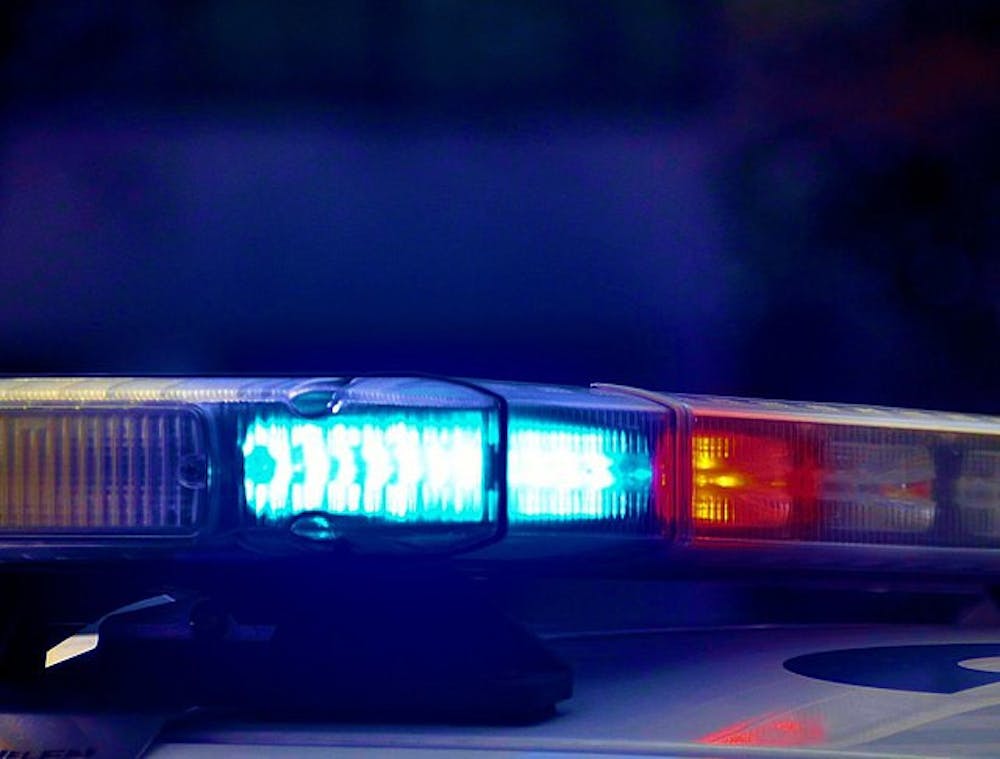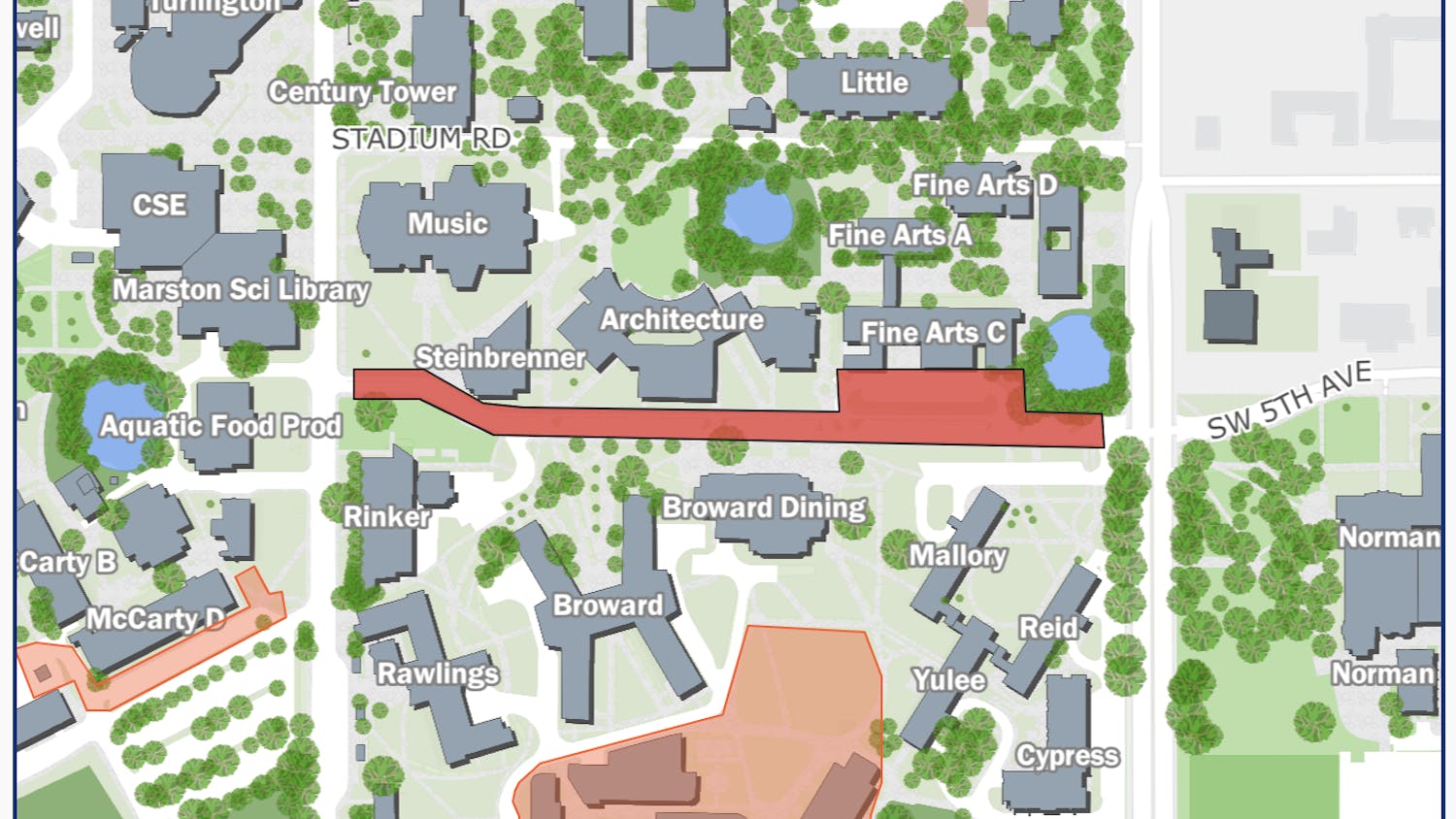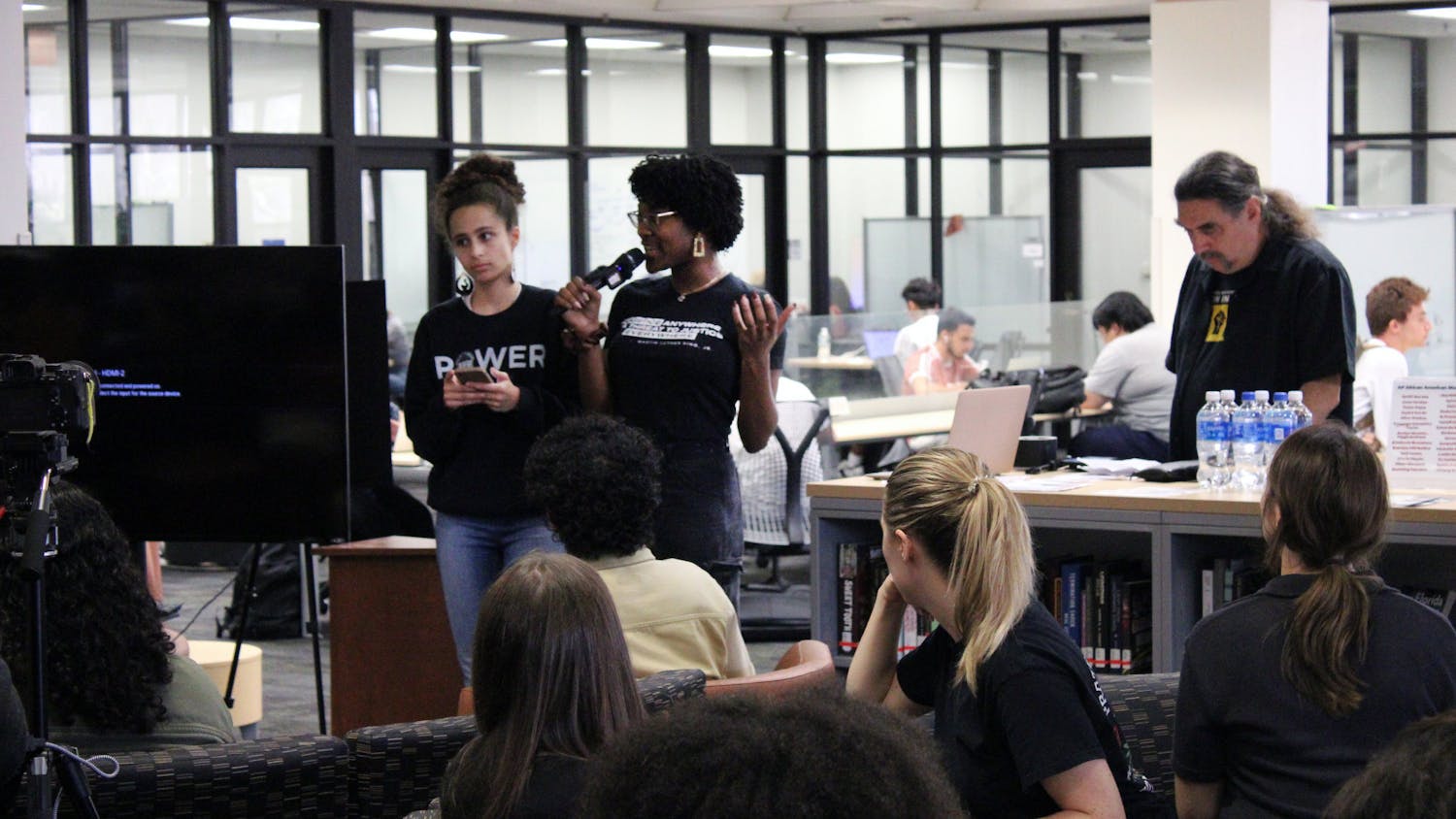Around 8 p.m. April 6, a call was made to the UF University Police Department, claiming a potential shooter was on their way to campus. Police increased patrol presence, including around Marston Science Library and Library West. But by 9:15 p.m., there were no officers in sight.
Police officials decided quickly there was no real threat, and therefore didn’t send an alert to students. However, UPD does thoroughly investigate threats like this, Sgt. Andrew McIntosh said.
At the time of the call, UPD treated the situation as a real threat, McIntosh said, but as it was getting initial information, beginning an investigation and putting personnel in place, UPD was able to identify the call as a hoax, he said.
“While UFPD swiftly determined the call was not credible, patrols were increased on campus for some time out of an abundance of caution,” UF spokesperson Cynthia Roldan wrote in an email. “As the investigation progressed, the department resumed normal operations.”
The university didn’t send out any alert about the call or heightened police presence, despite the Clery Act requiring an emergency alert to be sent when law enforcement receives “confirmation of an immediate threat to the health and safety of the campus community.”
UPD is now investigating the incident in conjunction with the FBI. The extent to which the FBI is involved in UPD’s investigation is unclear at the time of publication.
UF is just one of at least 16 colleges and universities that received a hoax call of a campus threat in April, according to an analysis by The Alligator. Many of these instances have been referred to by authorities as “swatting” — when a fake call is made to authorities to cause chaos and send a large amount of police to a certain location.
At least one major U.S. university was forced to respond to a fake active shooting threat every day for a week beginning April 3.
Of the 16 institutions' incidents, patterns have emerged in the nature of the calls. Fifteen were made in either the evening or early in the morning. 14 were threats of an active shooter on or approaching campus; and there were two bomb threats on two consecutive days.
There were also several discrepancies in the universities’ emergency notification system. Four of the schools, including UF, never sent an alert to their students. At least four sent alerts more than 30 minutes after the threat was received, often to the frustration of its campus population.
In the early morning hours, the Harvard University Police Department carried out an armed raid in Leverett House, according to The Harvard Crimson, Harvard’s independent student newspaper.
At least five Harvard University Police Department officers raided the suite of Harvard College seniors Jarah K. Cotton, Jazmin N. Dunlap, David G. Madzivanyika and Alexandra C. René. The officers, carrying assault rifles and wearing riot gear, ordered the students out at gunpoint around 4:15 a.m., the Crimson reported.
Three 911 calls were made within one hour from an individual who said he was armed and had taken a woman hostage, according to Harvard Police Chief Victor A. Clay.
The caller, who made note to identify as a male, said he had been kicked out of the university last semester. He also referenced a room number that indicated familiarity with Leverett House — one of the largest residential buildings at Harvard, Clay wrote.
In a third call, the caller indicated he was armed and would kill law enforcement if they entered the dorm room, according to Clay’s statement Wednesday.
Police were dispatched to Leverett House but declared the incident a swatting after clearing the situation, according to the Crimson.
Clay’s statement didn’t include why HUPD neglected to send out a public alert, despite the threat of an active shooter on campus.
“The steps we take are based on an assessment of the level of potential threat to members of our community with regards to a potential public safety situation,” Clay wrote.
HUPD spokesperson Steven G. Catalano declined to comment on the lack of an alert, according to the Crimson.
Rider is the only college campus with a swatting incident that didn’t occur at night. The Rider community received its first safety alert cautioning faculty and staff to stay or move inside at 1:16 p.m., according to The Rider News, Rider’s independent student newspaper.
The first alert was followed by a second alert two minutes later notifying the community that police were investigating a “threat made to campus.”
“This is not a drill,” the university said at 1:21 p.m.
Rider disclosed it had received a threat of a potential active shooter. Multiple students reported a high police presence at Hill Hall, a student dormitory, according to Rider News.
At 1:31 p.m., Lawrence Police Department and Rider public safety were investigating the threat, the update said. Seven minutes later, an update came in stating the Main and South entrance of campus were closed to entering and exiting traffic, and the shelter-in-place was still in order, Rider News reported.
A final update at 1:53 p.m. confirmed there was no active shooter but instructed classes to stay in session and to continue the shelter-in-place order.
The shelter-in-place lasted for 52 minutes, until 2:08 p.m.
Provost DonnaJean Fredeen thanked faculty through email for protecting students through the shelter-in-place order. Rider didn’t cancel the remainder of classes, but Fredeen encouraged faculty to be flexible in their attendance policy.
The Cornell University Public Communications Center received a threat of an armed shooter at 2:32 a.m., according to WHCU Radio. The caller told Cornell University’s police that he was armed and had injured a woman.
The caller said he was at Jameson Hall, a dormitory located on the north end of campus. Police officers were quickly dispatched, but they found no threat. The call mirrored others swatting events across the country, the university said, according to 14850, a local Ithaca news outlet.
The incident took place over Cornell’s Spring Break, when there was a lull in the campus population. It does not appear that Cornell University Campus Police issued a crime alert, based on their website.
Simmons Hall at MIT was evacuated after fire alarms blared around 2:30 a.m., according to Boston 25 News. One student noticed police officers responding instead of the fire department.
At 2:52 a.m., the school alerted students through email that Simmons had been evacuated following a bomb threat.
At 4:28 a.m., students were notified the threat had been cleared in a statement from the school: “After a thorough search, police have determined there is no threat to Simmons Hall and the building has been reopened.”
This swatting incident was the first in the college swatting series to be a bomb threat.
So far, no arrests have been made, according to Boston 25.
The small, Luthern university in Indiana’s heartland wasn’t exempt from the chaos, as police arrived at Beacon Hall, a co-ed campus dormitory, at 11:37 p.m. after a report of armed individuals in the area, according to The ValPo Torch, the university’s student newspaper.
Students received a shelter-in-place at 12:10 a.m. The Torch reported the reason for the more than 30-minute delay before students were alerted of a possible threat was not yet known as of April 6.
An investigation by the Valparaiso University Police Department, the Valparaiso City Police Department and the Porter County Sheriff’s Office found no threat after a search of multiple areas of campus.
The VUPD lifted the shelter-in-place order at 1:31 a.m.
It’s unclear what the exact nature of the reports sent to VUPD was.
Rutgers received a bomb threat at 2:15 a.m., according to The Daily Targum, Rutgers’ independent student newspaper.
The Rutgers University Police Department Communications Center reported the bomb threat targeted multiple buildings on College Avenue campus, the alert said. However, it was unclear which buildings were specifically targeted.
Rutgers University Police Department issued a university-wide alert at 3:35 a.m., calling for a shelter-in-place order. The order lasted until 5:42 a.m. The university used its emergency alert system to keep the Rutgers community updated, according to The Targum.
A third university alert at 7:21 a.m. explained the events of the night.
“The initial investigation confirmed that the incident was likely the result of a purposeful, non-credible threat known as 'swatting,'" RUPD Chief Kenneth Cop, said in the third alert.
The identity of the caller is still unknown at the time of publication, and no arrests have been made.
Clemson University police received the first of two 911 calls at 8:32 p.m. reporting two active shooters armed with rifles and wearing trench coats, according to The Tiger, Clemson’s independent student newspaper.
The Clemson University Police Department dispatched units to Cooper Library, where the caller said the armed assailants were, according to Police Chief Gregory Mullen.
Two officers entered the library but were unable to find any sign of active shooters. A total of nine CUPD and City of Clemson officers responded to the scene. Other emergency responders who were en route were canceled after no threat was found, The Tiger reported.
Additionally, no buses were found in the vicinity of Cooper Library. Dispatch reconnected with the caller, who said he was still in the area, but officers didn’t hear sirens in the background of the call. Based on the number of responding officers, sirens would’ve been prevalent, The Tiger said.
Twenty minutes later, at 8:52 p.m., the caller reconnected with dispatch to report another active shooter sighting at Cribb Hall. Officers responded to the call and confirmed the area was safe, despite declaring the previous incident a false alarm, Mullen said.
Police said they are investigating the origins of the call and have since included the South Carolina Law Enforcement Division and the FBI in their investigation, according to The Tiger.
The call was made through Voice over Internet Protocol, a “technology that allows you to make voice calls using a broadband Internet connection instead of a regular (or analog) phone line,” according to the Federal Communications Commission.
University police sent out the first safe alert to students 42 minutes after the first phone call. Police investigated reports of an active shooter on campus but deemed the threats false, the alert said. A second message, sent out at 9:38 p.m., confirmed there were no threats to campus at the time, according to The Tiger.
Mullen acknowledged why no safety alert was sent out at the time of the first call.
“Due to the quick arrival of officers and recognition that no threat existed, a determination was made that a safe alert was not needed and could create unnecessary panic, so one was not issued,” Mullen said.
The caller noted the shooters were wearing trench coats, which may be a reference to the 1999 Columbine shooting, in which the shooters were mythically part of a “Trench Coat Mafia.”
UCF received a disturbing call overnight about self-harm from an individual claiming to be in Lake Hall, a student dormitory, according to a statement issued by the University of Central Florida Police Department.
“Following a loud noise and a lack of response, a heavy police presence immediately responded to the residence hall. Officers went door to door to check on residents and ensure everyone’s safety. They did not locate the caller or observe any suspicious activity,” the statement read.
UCFPD reported no credible threats were made to the campus, and it is continuing to investigate the origin of the calls. Preliminary investigations traced the calls to an out-of-country online call service, according to UCFPD’s statement.
The department acknowledged UCF is part of a list of universities targeted by a “coordinated act of swatting.”
At 9:25 p.m., an alert blared on the phones of every student at the University of Oklahoma, according to the OU Daily, the university’s independent student newspaper.
“There is an active shooter at Van Vleet Oval. Take immediate action now. Run. Hide. Fight!”
Just one minute before, the university received multiple calls reporting an active shooter at the campus’ South Oval and Bizzell Memorial Library.
Twenty minutes later: “Another South Oval area. Shelter in place.”
For the next hour and a half after the call, the campus would be in lockdown as over 100 responding police swept the area in pursuit of a shooter. A SWAT team, ambulances and BearCat armored rescue vehicles were deployed.
It was not until 10:42 p.m. that April Sandefer, OU Director of Media Relations, told the OU Daily that at that point, the investigation had resulted in no indication of a shooting.
“We are still advising everyone to shelter in place, but that’s all I know at this point," Sandefer said in a statement.
Twelve minutes later, the Oklahoma University Police Department issued an all-clear after half an hour of confusion, fear and social media speculation in Norman.
The OU Daily reported Sunday that the FBI had assisted the university in an investigation of the events and determined it was a swatting incident; and that they believed the call was likely made from outside the U.S.
Cedar City police officers responded to a 911 call reporting gunshots at Gerald R. Sherratt Library on SUU’s campus Saturday night, according to KSL News.
The Spectrum reports a several-hour lockdown on SUU’s campus beginning late Saturday and continuing into the early morning hours of Sunday.
SUU sent out an alert at 9:16 p.m. that police were investigating campus after an emergency 911 call reporting gunshots at the library, according to the alert. The alert informed faculty and students that police were still investigating the rest of campus.
Cedar City police issued the “all-clear” just before 1 a.m. after spending hours searching through campus buildings, according to Spectrum.
Police responded immediately and evacuated the library, according to an SUU Twitter thread.
The university received multiple calls just before 8 p.m. reporting an active shooter at the College of Fine Arts Building and the Admissions Building, according to The Daily Free Press, BU’s independent student newspaper.
BU sent out a campus-wide alert at 7:59 p.m. of the threat and of a substantial police presence at both locations.
Students were under lockdown in the university’s George Sherman Union, College of Fine Arts, and College of Arts and Sciences. Those who spoke to The Daily Free Press reported heavily armed police escorting students outside of the buildings and students inside barricading doors to keep out a would-be gunman.
The next alert at 8:25 p.m. instructed students not to call the Boston University Police Department for information and that at the time, there was no indication of a real threat.
Upon their arrival at the two locations, the police responders — which included BUPD, the Brookline Police Department, the Boston Police Department and the Massachusetts State Police — found no indication of active shooters.
The final alert at 8:48 p.m. said police were confident there was no threat of an active shooter on campus.
“We’re working to identify information related to the source of the calls, using whatever information is provided, whether it’s a phone number, an email account or anything like that,” BU spokesperson Colin Riley said, according to The Daily Free Press. “You don’t know the motivation behind this. It speaks to a disturbed individual, unfortunately.”
Monday, BU Student Government endorsed an open letter calling for an update of university emergency protocols and lockdown procedures, as well as an update on the hoax since the final alert the day before, according to The Daily Free Press.
The Winston-Salem Police Department responded to an anonymous call that shots were fired near Wake Forest University’s Reynolda Hall Sunday night, according to The Old Gold & Black, the university’s student newspaper.
After police found no evidence of a shooting or injuries, Wake Forest sent out an alert at 9:03 p.m. that no gunshots were fired on campus.
It’s currently unclear at what time the initial call of a threat was made, only that it was received by WSPD and forwarded to the Wake Forest Police Department that evening.
More than a dozen police cars and a SWAT team responded to a threat at the north end of campus local time later revealed to be a swatting hoax, according to The Nevada Sagebrush, the university’s student newspaper.
Brian Sandoval, the UNR president, said in a statement Monday that university police and local first responders responded to a call received around 8:24 p.m. Sunday that claimed there was an active shooter on campus.
“It has been determined that this was a ‘swatting’ call, which is meant to generate an emergency response under false pretenses,” Sandoval said. “Although the campus was cleared by University Police within 15 minutes of having received the call, we use instances like this to review and refine our public safety procedures and policies as they relate to all emergency situations.”
The Sagebrush confirmed to The Alligator that students didn’t receive an emergency alert until after the police had determined there was no threat and said students on social media were upset about what they felt was a lack of response from UNR.
Police responded to a call that reported an active shooter at the Davis Family Library around 10:30 p.m., according to The Middlebury Campus, the college’s student newspaper.
The Campus reported that by the time police had evacuated the library and allowed students to return to their dorms, the college had not yet sent out an emergency notification as news of the threat spread on social media, which led to frustration by students and parents.
Students received a MIDDALERT notification at 11:53 p.m. that reported police officers were at the library in response to a report of an active shooter, but the threat did not seem credible. At 12:24 a.m., the college alerted students there was no credible threat and the shelter-in-place order was lifted.
The investigation of the origin of the threat has been handed over to the FBI, Middlebury Police Department Sergeant Vegar Boe told The Campus.
Monday evening, the University of Pittsburgh Police Department and the City of Pittsburgh Police Department responded to calls of an active shooter on campus, according to a tweet from the university.
There were three calls in total made to Pittsburgh Police, the first at 11:10 p.m., according to reporting from WPXI. Jim Loftus, the Pittsburgh Chief of Police, said in a press conference Tuesday there were gunshots or simulated gunshots heard by the responder of the call.
Pittsburgh Public Safety tweeted at 11:59 p.m. Monday that police had responded to a report of a possible active shooter at the university’s Hillman Library, only to later clear the building of having any threat.
After responding to multiple locations, including Mervis Hall, officers cleared the area and determined the calls were unfounded.
“Officers have responded and cleared the locations,” the tweet said. “It has been determined that the calls were unfounded. Investigation continues into the source of these hoax calls.”
Some students expressed frustration that it was more than an hour after police evacuated the library that the university sent out a safety alert, according to Pitt News, the campus’ student newspaper.
In a statement Tuesday morning, the University of Pittsburgh said its Emergency Notification System (ENS) message was both delayed and flawed.
Loftus said police decided to wait until Hillman and Mervis were cleared, with one alert sent at 12:36 a.m. and another at 1:01 saying the threat was false, according to Pitt News.
“My regret and my responsibility is that we didn’t get the ENS message out as quickly as I think we could have or should have and that rests with me,” Chief Loftus said.
The FBI is assisting local authorities in the investigation, according to WPXI.
This is a developing story. Check back for updates.
Contact Ella at ethompson@alligator.org. Follow her on Twitter @elladeethompson.
Contact Christian at ccasale@alligator.org. Follow him on Twitter @vanityhack.

Christian Casale is a history senior and the university desk editor for The Alligator. In his spare time, he loves writing his bio for the website and watching movies alone in the dark.
Ella Thompson is the Spring 2025 Editor-in-Chief and a fourth-year journalism major. She also worked as the Fall 2024 Digital Managing Editor and the Spring 2024 metro editor. In her free time, she can be found reading, planning a trip or journaling.






